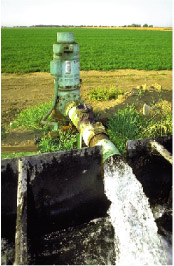National Water Census
 The 21st Century brings a new set of water resource challenges. Water shortage and use conflict have become more commonplace in many areas of the United States – even in normal water years – for irrigation of crops, for growing cities and communities, for energy production, and for the environment and species protected under the law. Much has changed since the last overall assessment of water resources for the Nation was published by the Water Resources Council in 1978.
The 21st Century brings a new set of water resource challenges. Water shortage and use conflict have become more commonplace in many areas of the United States – even in normal water years – for irrigation of crops, for growing cities and communities, for energy production, and for the environment and species protected under the law. Much has changed since the last overall assessment of water resources for the Nation was published by the Water Resources Council in 1978.
It is time for a comprehensive examination of water availability in the United States using what we have learned during the past thirty years and with up-to-date capabilities. In response to a request from Congress, the USGS released a report in 2002 entitled, Concepts for National Assessment of Water Availability and Use, Circular 1223. The circular outlines a broad framework by which a national assessment could take place and advocates using 21 Water Resources Regions for the study units.
In 2005, USGS embarked on a pilot study of water availability in the Great Lakes Basin. The pilot focuses on understanding the dynamics of the water resources in the basin in terms of the flows and yields of both ground and surface water and demonstrates the importance of water-use data to quantifying water availability.
In 2007, the US Geological Survey released its ten year science strategy in the form of Facing Tomorrow's Challenges -- U.S. Geological Survey Science in the Decade 2007-2017 Circular 1309. One of the seven major strategic directions identified in the Circular is “A Water Census if the United States: Quantifying, Forecasting, and Securing Freshwater for America’s Future. These are the initial steps to implementing a National Water Census and producing a water availability and use assessment for America.
In the next decade, the Nation will need new appraisal for water availability that links both water quality and quantity, tracks changing flow, use, and storage of water, as well as developing models and predictive tools to guide its decisions. In 2007, the National Science and Technology Council (NSTC) released a report entitled “A Strategy for Federal Science and Technology to Support Water Availability and Quality in the United States.” That report stated, “The United States has a strong need for an ongoing census of water that describes the status of our Nation’s water resource at any point in time and identifies trends over time.” In its simplest terms the philosophy of the initiative is “You can’t manage what you don’t measure.” Knowing our nation’s water “assets” and rates of use on an ongoing basis is crucial to wise management. The USGS will release an implementation plan in the fall of 2009, demonstrating how the Bureau will put the National Water Census into operation. In this plan, the USGS will:
The USGS goal is to place technical information and tools into the hands of stakeholders that allow them to evaluate water availability for the questions that they are facing. The responsibility for management of water supplies rests at the State and local government level, but knowledge of the hydrologic system is needed across State lines. Therefore, we need to provide a seamless national database of water availability data across jurisdictional boundaries. The National Water Census will use and build on data and assessments accomplished through State and local initiatives, as well as information produced under programs such as the Cooperative Water Program. The National Water Census will also use the strength of other Bureau programs such as:
The products of the National Water Census will include
"The USGS should focus on the scientific integration of water use, water flow, and water quality in order to expand knowledge and generate policy-relevant information about human impacts on both water and ecological resources."
from: Estimating water use in the United States: A New Paradigm for the National Water-Use Information Program.
"The United States has a strong need for an ongoing census of water that describes the status of our Nation's water resource at any point in time and identifies trends over time."
from: A Strategy for Federal Science and Technology to Support Water Availability and Quality in the United States.